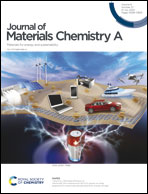Atomically thin mesoporous NiCo2O4 grown on holey graphene for enhanced pseudocapacitive energy storage†
Abstract
Pseudocapacitive energy storage via Li+ storage at the surface/interface of the electrode is promising for achieving both high energy density and high power density in lithium-ion batteries (LIBs). Thus, we created holey graphene (HG) via an etching method, and then in situ grew atomically thin mesoporous NiCo2O4 nanosheets on the HG surface, resulting in a NiCo2O4–HG heterostructure. Since both NiCo2O4 and HG possess atomic thickness and porous structures, the as-prepared nanocomposite enables efficient electrolyte diffusion and mass transfer, providing abundant accessible surface atoms for enhanced redox pseudocapacitance. Moreover, the strong coupling effect between NiCo2O4 and graphene produces an ultra-large interfacial area and enhanced electrical conductivity, and subsequently promotes the intercalation pseudocapacitance. Consequently, the NiCo2O4@HG exhibits a high specific capacity of 1103.4 mA h g−1 at 0.2C, ∼88.9% contribution from pseudocapacitance at 1 mV s−1, excellent rate capability, and ultra-long life up to 450 cycles with 931.2 mA h g−1 retention, significantly outperforming previously reported electrodes. This work suggests that the maximum exposure and utilization of the surface/interfacial active sites is vital for the construction of high-performance pseudocapacitive energy storage devices.

- This article is part of the themed collection: Journal of Materials Chemistry A HOT Papers


 Please wait while we load your content...
Please wait while we load your content...